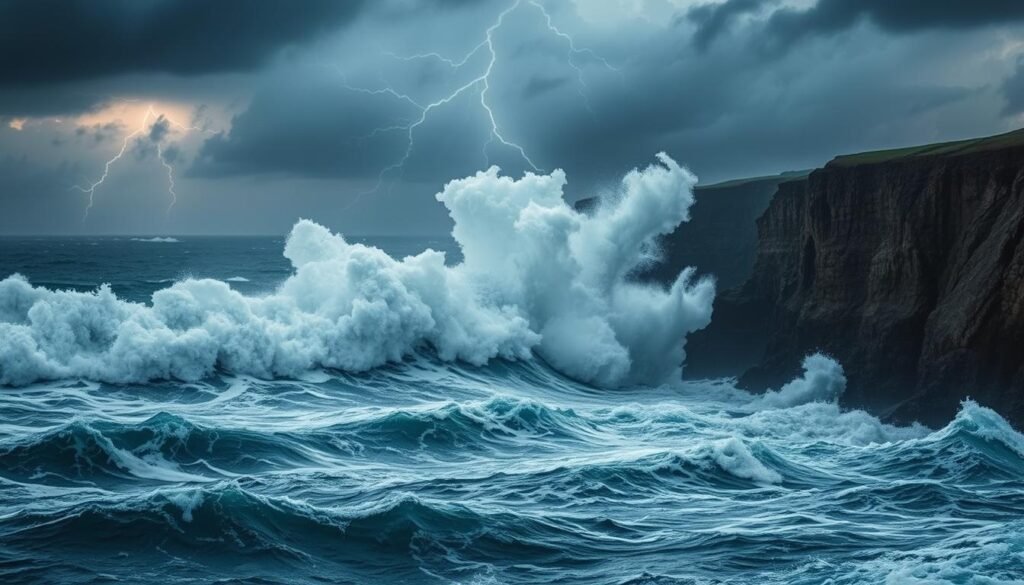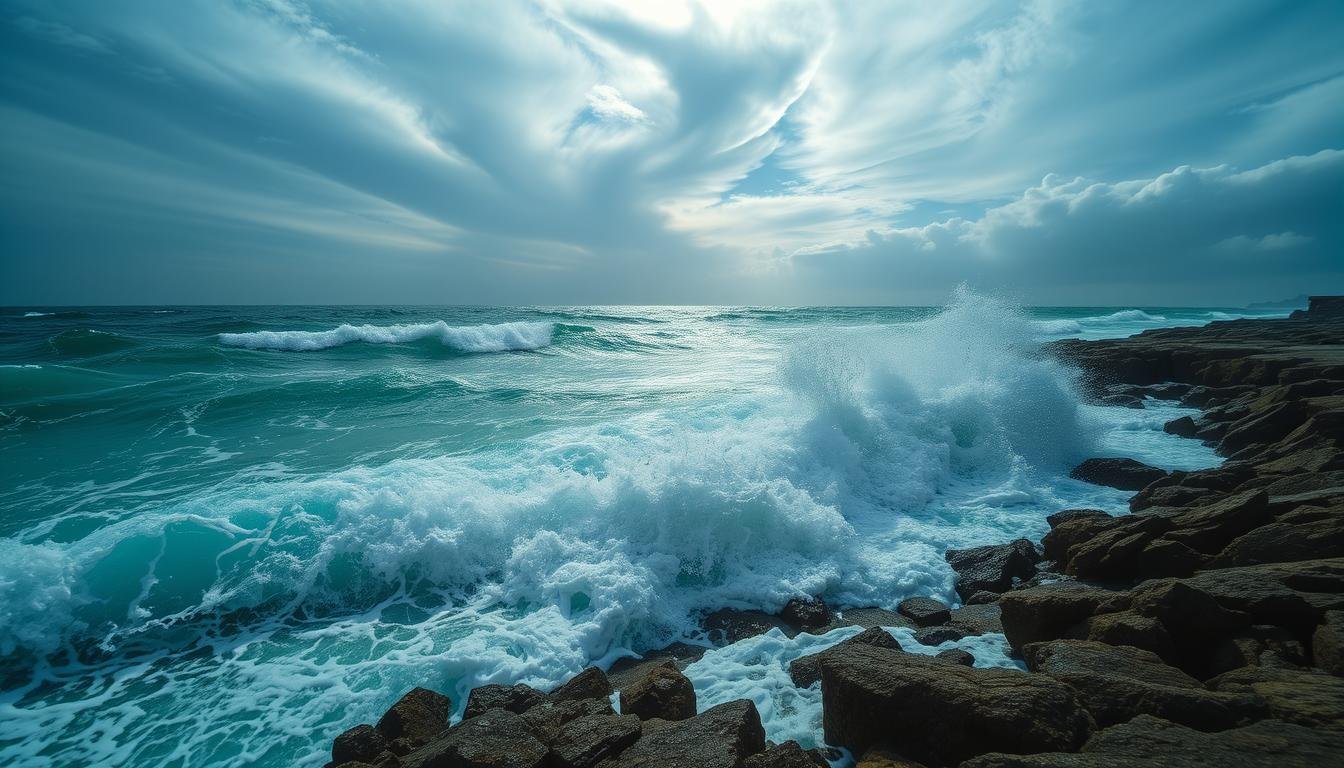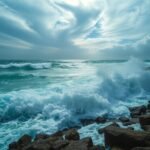The ocean is always changing, with waves moving across its surface. These waves are made when energy moves through the water, making it move in circles. But, the water itself doesn’t move in waves. Instead, the waves carry energy across the ocean’s surface.
Wind is the main force behind these waves. When wind hits the water, it creates a disturbance. This disturbance leads to the formation of wave crests.
Key Takeaways
- Wind is the primary cause of surface waves, as the friction between wind and water creates disturbances that lead to wave formation.
- Waves are described as energy passing through water, resulting in circular motion of water particles without significant displacement.
- Severe weather events, such as storms and hurricanes, can generate long waves known as storm surges and tsunamis, which can have catastrophic impacts on coastal areas.
- The uneven heating of the Earth’s surface by the sun drives wind patterns, which in turn influence the creation and dynamics of ocean waves.
- Wave behavior and characteristics differ between deep and shallow water, with deep water waves forming large swells and shallow water waves interacting with the seafloor to create breaking waves.
Understanding the Nature of Ocean Waves
To get a grasp on ocean waves, we need to know how they form and move. At their heart, waves show us the energy moving through the sea.
Many think waves are moving water. But, the truth is, the water in a wave moves in a circular motion. The surface water goes up, slows, and then drops back down. This circular movement of water particles makes it seem like waves are moving across the ocean.
What are Waves?
Waves happen when energy moves through the water movement. This energy comes from wind, tides, or underwater events. As this energy spreads, it makes the water particles move in circles. This creates the wave-like motion we see on the ocean surface.
The Circular Motion of Water Particles
The way water particles move in a circle is key to understanding waves. As energy moves through the water, the water particles follow a circular path. The surface water goes up, slows, and then drops back down. This circular motion is what makes waves look like they’re moving and how energy is passed across the ocean surface.
“The motion of waves is a dance of energy moving across the surface of the sea.” – Deepak Chopra
Wind: The Primary Cause of Surface Waves

The wind blowing over the ocean or a lake creates waves. As the wind hits the water, it makes the surface move in circles. This creates a wave crest.
The wind keeps disturbing the water, making these waves. They can be found everywhere in the open ocean and along coasts.
Wind-Driven Waves and Friction
The wind moving over the water creates ocean currents and waves. The friction between the air and water affects this process. This friction is strongest in the top 300 m to 3 km of the atmosphere.
The thickness of this layer changes the wind speeds above it. This impacts the wind energy transferred to the water.
The Formation of Wave Crests
Waves move energy, not water. This is seen in the circular motion of water particles. The size of waves depends on several factors.
These include wind speed, the distance the wind blows, and the water depth. As waves move, they group together by direction and wavelength. This forms swells.
| Characteristics | Values |
|---|---|
| Wind Waves Size | From small ripples to over 30m (100ft) high |
| Wave Travel Distance | Thousands of kilometers as swells |
| Significant Wave Height | Average of the highest one-third of waves |
| Main Wave Types | Capillary waves, gravity waves, and locally generated seas |
“Wind is the most common cause of ocean waves, creating friction with the ocean’s surface, leading to ripples that grow into larger waves, traveling thousands of miles, with stronger winds like in hurricanes creating storm surges of long waves.”
Severe Weather and Hazardous Waves

Nature’s power can bring severe weather that makes ocean waves dangerous. Storm surges and hurricanes are big reasons for these waves.
Storm Surges and Hurricanes
When storms move inland, they create a storm surge. This is a long wave from high winds and low pressure. It can flood coastal areas like a sea level rise.
Hurricanes are especially bad for storm surges. They can make waves up to 20 feet high. This leads to a lot of flooding and damage.
Tsunamis and Underwater Disturbances
Underwater earthquakes, landslides, or volcanoes can also cause trouble. They make long waves called tsunamis. Tsunamis come onto the shore fast, without warning.
These waves can move up to 500 miles per hour. They are a big danger to people living by the coast.
| Hazardous Wave Condition | Key Characteristics | Potential Impacts |
|---|---|---|
| Storm Surge | Long waves caused by high winds and low pressure during severe storms | Extensive flooding, coastal destruction, and threat to human life |
| Tsunamis | Series of long waves generated by underwater disturbances like earthquakes or landslides | Rapid and devastating flooding, significant damage to coastal infrastructure, and a major threat to public safety |
Severe weather and underwater troubles can make waves that are very dangerous for coastlines. It’s important for coastal areas to know about these dangers. This helps them get ready and respond to natural disasters.
The Tidal Effect on Ocean Waves

The sun and moon pull on the Earth, causing tides. These tides affect ocean waves. This pull leads to water levels rising and falling, which is vital for the oceans.
Every 24 hours and 50 minutes, the Earth goes through two tidal swells. This means we get two high tides and two low tides each day. The sun and moon must be in line for the biggest spring tides. When they are at a right angle, we get neap tides with smaller water levels.
| Tidal Event | Description |
|---|---|
| Spring Tide | Occurs when the sun and moon are aligned, leading to larger tidal ranges. |
| Neap Tide | Happens when the sun and moon are at a right angle, resulting in smaller tidal ranges. |
| Tidal Bore | A wave of increased height that can form in estuaries, such as the Amazon River’s pororoca. |
The tidal effect on ocean waves is more than just water levels. Winds and currents, shaped by the Coriolis effect, also play a part. They mix with tides to create special wave patterns in both deep and shallow waters.
It’s important to understand how tides, winds, and currents work together. This knowledge helps coastal communities, marine life, and many human activities. It’s key for surfing, swimming, tidal power generation, and oceanographic research.
Ocean Waves and the Sun’s Energy

The sun’s energy is key in making ocean waves. The sun’s rays heat the Earth’s surface unevenly. This uneven heating creates wind, which then makes waves on the ocean.
Uneven Heating and Wind Formation
The sun’s rays heat the Earth’s surface unevenly. The equatorial regions get more heat than the poles. This makes hot air rise near the equator, creating low-pressure areas.
Cooler air moves into these areas, creating wind. Wind is driven by temperature and pressure differences.
The Transfer of Wind Energy to Water
When wind hits the ocean’s surface, it gives its energy to the water. This makes the water particles move in circles. These circular motions create waves, from small ripples to big swells.
The sun’s energy is the main force behind water movement and wind energy in the oceans. This happens through uneven heating and wind formation.
“The ocean is the lifeblood of our planet, covering more than 70 percent of the Earth’s surface and containing 97 percent of the planet’s water.”
Wave Dynamics in Deep and Shallow Water

Ocean waves act differently based on water depth. In deep water, waves are huge swells that look like rolling hills. These swells can travel for thousands of miles, pushed by the wind. But when they hit the shallow water near the coast, the water’s circular motion changes due to the seafloor.
Swells and Rolling Hills
In deep water, waves keep their shape due to the water’s circular motion. This lets them travel far without losing much energy. The wave’s height and length depend on the wind’s strength and how long it blows.
Breaking Waves and Coastal Interactions
When waves reach the shore, they start to interact with the shallower water. The lower part of the wave slows down, making the top go higher. This imbalance leads to the wave breaking and crashing down, losing its energy. This process is key to understanding how the ocean and coast interact.
| Wave Characteristic | Deep Water | Shallow Water |
|---|---|---|
| Wave Speed (Celerity) | C = 3.13 √d (meters) or C = 5.67 √d (feet) | Dependent on water depth and wavelength |
| Wave Height to Wavelength Ratio (H/L) | No limit | H/L = 1/7 |
| Wave Breaking | Infrequent | Frequent, with crest peak less than 120° |
Knowing how deep-water and shallow-water waves work is vital for managing coastlines. It helps in engineering and activities like surfing and swimming. By studying these patterns, experts can better predict and use the ocean’s wave energy dissipation.
Ocean Waves and Their Impact

Ocean waves deeply affect our lives and the environment. They bring joy through surfing and swimming. They also hold energy for renewable power and are key in ocean studies and coastal protection.
Surfing, Swimming, and Coastal Recreation
Many find joy in riding ocean waves. Surfers use their skills to enjoy the waves’ power and beauty. Swimming and other activities like beachcombing offer a chance to relax by the sea.
Wave Energy and Oceanography
Wave energy is seen as a clean power source. Scientists work on turning this energy into electricity. Studying waves helps us understand the ocean and protect our coasts.
| Metric | Value |
|---|---|
| Tidal Periods | 12 to 24 hours |
| Tidal Wavelengths | Hundreds to Thousands of Kilometers |
| Tidal Ranges in Open-Sea | Exceeding 10 Meters |
| Storm Surge Periods | 1 to 2 Days |
| Storm Surge Wavelengths | A Few Hundred Kilometers |
| Tsunami Periods | 1 to 20 Minutes |
| Tsunami Wavelengths | A Few to Hundreds of Kilometers |
| Wind-Generated Wave Periods | Less Than 20 Seconds |
Ocean waves have a big impact on us and the environment. They bring joy and power for energy. They also drive research and help protect our coasts.
Also Read : How To Pack For A Stress-free Beach Trip
Conclusion
Ocean waves show the beauty and complexity of our planet’s oceans. They are shaped by wind, weather, and the Earth’s forces. From small ripples to huge swells, knowing about ocean waves helps us enjoy and protect the seas.
We’ve looked at how waves are made and how they change. Wind, weather, tides, and the sun all play a part. Waves also affect our lives, from surfing to using wave energy.
Looking ahead, wave energy could be a big help for our planet. With new tech and caring for our oceans, we can live better with the sea. Studying waves teaches us how to respect and enjoy the ocean’s power.
FAQs
Q: What causes ocean waves and how do wind and weather play a role in their creation?
A: Ocean waves are primarily caused by the wind blowing across the surface of bodies of water. The strength and duration of the wind, along with the distance over which it blows, determine the size and energy of the waves that occur.
Q: How do we understand ocean waves in relation to weather conditions?
A: To understand ocean waves, we must consider various weather factors such as wind speed, direction, and atmospheric pressure. These elements can significantly influence the height and frequency of waves, leading to different wave patterns.
Q: Can you explain the role of surface water in the creation of waves?
A: Surface water is essential in the formation of ocean waves. As the wind blows across the water, it transfers energy to the surface, causing the water to move in a circular motion, creating waves that can travel long distances.
Q: What are the different types of waves that occur in deep water?
A: In deep water, waves are categorized into two main types: wind-generated waves and swell. Wind-generated waves occur close to the shore, while swell represents waves that have traveled long distances and are more uniform in appearance.
Q: How do waves travel across the ocean, and what factors affect their movement?
A: Waves can travel across the ocean due to the energy imparted by the wind. Factors such as water depth, wind speed, and the presence of other waves can influence how these waves propagate and their overall characteristics.
Q: What is the significance of the trough and crest in wave formation?
A: The trough is the lowest point of a wave, while the crest is the highest point. The distance between the trough and crest is crucial for understanding the wave’s energy and potential impact on coastal areas.
Q: How does the age of a wave influence its characteristics?
A: The age of a wave affects its shape and energy. Younger waves, created by recent wind activity, tend to be more chaotic and steep, while older waves have traveled further and become smoother and more organized.
Q: What role does animation play in illustrating ocean wave dynamics?
A: Animation, such as that seen in works directed by Tomomi Mochizuki, can effectively illustrate ocean wave dynamics by visually representing the movement from trough to crest, helping audiences better understand the complex interactions between wind, weather, and waves.
Q: Why is it important to explore the science behind ocean waves?
A: Exploring the science behind ocean waves is essential for various reasons, including predicting weather patterns, understanding coastal erosion, and ensuring the safety of maritime activities. Knowledge of wave behavior can also aid in environmental conservation efforts.
Source Links
- https://oceanexplorer.noaa.gov/facts/waves.html
- https://www.whoi.edu/know-your-ocean/did-you-know/what-causes-ocean-waves/
- https://ocean.si.edu/planet-ocean/tides-currents/currents-waves-and-tides
- https://deepakchopra.medium.com/a-life-changing-choice-the-wave-or-the-ocean-a59405a82bd6
- https://en.wikipedia.org/wiki/Wind_wave





